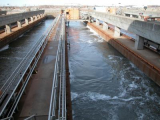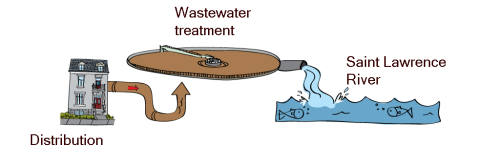The largest treatment plant in North America

Montreal’s daily production of wastewater ranges from 2.5 million m3 on dry days up to 7.6 million m3/day on rainy days. On average, we produce enough wastewater each day to fill the Olympic Stadium, and that water needs to be treated before it is returned to the Saint Lawrence River.
The water treatment plant that deals with the majority of the city’s water is the Jean-R. Marcotte plant in Pointe aux Trembles, at the eastern tip of the island. (Montreal also has a very small plant to treat the water on Île Notre Dame and Île Ste. Hélène.) The Jean-R. Marcotte plant is the largest in North America, the third largest in the world, and it deals with 50% of all water treated in the province of Quebec.
Photo: David Richfield. Wikipedia.org.
Creative Commons Attribution-Share Alike 3.0 Unported license
.
Everyone lives downstream from someone else
Size isn’t everything, however, and in terms of wastewater treatment, Montreal is behind the times compared to many other cities. In fact, it was the last major city in North America to begin treating its wastewater. In addition, Montreal’s plant only carries out primary treatment of sewage, which removes solids and some nutrients but leaves behind bacteria, viruses, pharmaceuticals, heavy metals, and other contaminants.

Illustration: Genevieve Young

When the water leaves the Jean-R. Marcotte plant, all of those untreated substances are dumped back into the Saint Lawrence River, and downstream ecosystems are showing the effects. A 2011 study by the Université de Montréal’s Chemistry Department showed that antidepressants in the water, although not harmful to humans, are affecting fish.
Photo: Brook trout: Université de Montréal.
In addition, treatment of any kind may be bypassed when there are heavy rains and the collector system or pumps cannot handle the extra water. Why can't the collectors handle heavy rains? Because 63% of Montreal's territory still uses combined sewers, which funnel storm water into the same collectors receiving our residential and industrial waste water. When collectors cannot handle the extra volume of water, raw sewage is released directly into the waters surrounding our island city.
It's time for cleaner water
 In 2004, the Sierra Club gave Montreal’s water treatment process an F, which puts us on a par with places that don’t treat their water at all. In 2008, the City announced that it wants to convert the Jean-R. Marcotte plant into an ozonation treatment facility, which would provide tertiary treatment of wastewater before it is released into the Saint Lawrence. Ozonation uses ozone, a powerful oxidizer, to disinfect water, and the City already uses ozonation to disinfect our drinking water at certain of its treatment plants. Ozonation effectively destroys bacteria and viruses in wastewater and it is believed to reduce the amount of pharmaceuticals, industrial chemicals, and personal care products left in the water. The ozonation process does this by causing the products to break down and decompose. The latest news is that the ozonation upgrade will be ready in 2015.
In 2004, the Sierra Club gave Montreal’s water treatment process an F, which puts us on a par with places that don’t treat their water at all. In 2008, the City announced that it wants to convert the Jean-R. Marcotte plant into an ozonation treatment facility, which would provide tertiary treatment of wastewater before it is released into the Saint Lawrence. Ozonation uses ozone, a powerful oxidizer, to disinfect water, and the City already uses ozonation to disinfect our drinking water at certain of its treatment plants. Ozonation effectively destroys bacteria and viruses in wastewater and it is believed to reduce the amount of pharmaceuticals, industrial chemicals, and personal care products left in the water. The ozonation process does this by causing the products to break down and decompose. The latest news is that the ozonation upgrade will be ready in 2015.
For more information, see the City of Montreal website.
For a unique look at Montreal’s sewer system, check out Under Montreal.